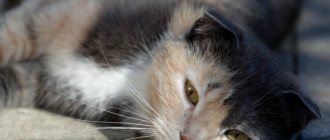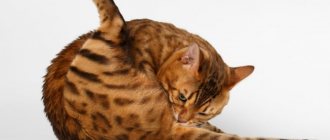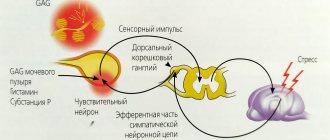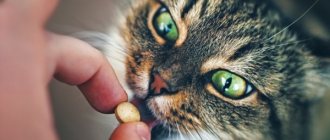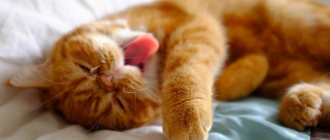Causes of the disease
Cats' ears are an extremely vulnerable place, which is why the occurrence of otitis media is quite common. There are many reasons for the occurrence of the disease, let’s consider the main ones:
- Hypothermia – usually occurs after careless swimming and water getting into the animal’s ear. It could also be the cat staying in a draft for a long time.
- Allergy - this can be a reaction to food or waste products of parasites, a complication of dermatitis due to pets scratching the affected area and infection getting inside the ear.
- Parasites – ear and subcutaneous mites, fleas. They damage the delicate skin of the ears, causing infection.
- Fungal infection is typical for animals with reduced immunity. Even opportunistic flora that normally lives on a cat’s skin can cause inflammation.
- Traumatization – damage to the ears during fights, when scratching or scratching with foreign objects.
- Inflammation of the organs of the oropharynx - due to the peculiarities of the anatomy, otitis media can be caused by infectious diseases of the gums, nose, teeth and throat.
- Failure to comply with care - excessive deposits of sulfur can lead to blockage of passages and cause the development of an inflammatory process.
Otitis in cats - why does otitis develop in cats?
Otitis is an inflammation of the ear in cats, dogs and other pets. In cats, as a rule, inflammation of the outer and middle ear is frequent; inflammation of the inner ear occurs less frequently. In an animal, such a disease usually affects either only one or both ears at once, and it can develop due to many different reasons.
Why does otitis media develop in cats?
Most often, cats develop otitis due to injury to the outer ear (tick bite, wounds received after a fight with another animal, after an allergy to food, detergent or any medication).
Otitis media in cats is a hearing disease and is not contagious.
Signs of feline otitis media
Have you noticed that your pet often shakes its head or feels pain when its head is touched near its ears? This is probably how the first symptoms of this disease appear. To learn more about this disease, you need to look at the symptoms of feline otitis media in more detail.
Symptoms of otitis media in cats:
- the skin inside the ear becomes red;
- there is a bad smell from the ears;
- pus or blood are discharged from the ears;
- the cat sometimes goes deaf;
- it is difficult for the animal to chew dry food (or natural but hard food);
- there is discharge from the eyes;
- if a complication develops, inflammation of the lymph nodes under the jaw, vestibular apparatus, as well as meningitis may occur.
How to treat otitis media in cats
If your pet develops otitis media, you must immediately take him to a veterinarian, who will competently prescribe treatment for otitis media in cats , based on the type of disease.
- Purulent feline otitis media. Pus is leaking from the cat's ear. When this disease reaches an advanced stage, the animal may develop perforation of the eardrum, as well as ulcerative processes. Antibacterial drugs are used in therapy, as well as chlorhexidine solution and hydrogen peroxide.
- Chronic feline otitis media. This is the result of infection with streptococcal and staphylococcal bacteria, Pseudomonas aeruginosa or Escherichia coli. This type of disease must be treated in accordance with special guidelines and under the constant supervision of a veterinarian. Antibacterial agents, compresses with dexamethasone and the drug “Candibiotic” are used in therapy.
- Feline otitis externa is a disease of the outer ear, the main symptom of which is a bacterial-fungal infection of the ear canal or an inflammatory process of the hair follicle, accompanied by a feeling of itching, swelling, and eczema. The drug Vetzim is used for treatment.
- Fungal feline otitis media. It is also called otomycosis. It can be not only an independent disease, but also a secondary disease. Due to the presence of an inflammatory process, the skin loses its protective properties, as a result, the fungus gives rise to infection and otitis media appears. It all starts with very severe itching, then sulfur discharge appears in large quantities, then redness appears on the ear - this is how this type of otitis begins. Probably, the consequence of this process will be swelling, purulent discharge, and a bad odor. In order to cure the fungal type of otitis, a solution of phosphoric acid is used to treat the ear, as well as the “Gaselan” product.
- Bacterial feline otitis media. A fairly common occurrence that can affect either one or two ears at once. This disease is accompanied by itching, pus, bad odor, and severe redness. For this type of disease, the drug Surolan is used for therapy.
- Allergic feline otitis media. Disease of the concha of the ear, which is a consequence of allergies. In addition, it can be triggered by an imbalance in the hormonal system. A large amount of earwax appears and severe itching. In order to get rid of such a disease, it is necessary to eliminate the cause of the allergic reaction.
In a situation where the treatment was quite long, but no obvious results are observed, you need to pay attention to the selection of medications, which was probably incorrect. We must not forget that although the drug for otitis media for cats can be bought at a veterinary pharmacy, it is better that it be prescribed by a veterinarian who has carefully examined the pet.
Types of otitis
The cat's ear consists of three main sections - the external (outer) ear, middle and inner ear. Based on these anatomical features, several forms of the disease are distinguished:
- Otitis externa - affects the outer part of the ear, the symptoms are usually mild, the most common form of the disease with a good outcome and simple treatment.
- Otitis media of the middle ear – general symptoms of inflammation appear, treatment is complicated, but in most cases the prognosis is favorable.
- Otitis of the inner ear is the most severe form, often occurs with complications, and the animal’s well-being suffers greatly. If you do not contact a veterinarian in time, your pet may even die from cerebral edema.
With improper or absent treatment, the acute form may transition to chronic. It is characterized by a long course with periodic exacerbations. Also, special attention should be paid to careful care and prevention of the cat in order to reduce the risk of exacerbations. A malignant development of the disease with the development of a purulent process is possible; in these cases, surgery may be required.
Otitis media in cats: causes, symptoms and treatment, photos
Having a pet is not only a great joy, but also a great responsibility, because a kitten is not a toy, but a living being that needs attention and care.
When an animal gets sick, it largely depends on the owner how quickly the recovery will be - the owner must be able to recognize the symptoms in time and not delay a visit to the veterinarian. Ear problems are one of the most common pathologies in cats.
Otitis is an inflammatory process that can be caused by various reasons.
Causes of otitis media in cats
The hearing organ of representatives of the cat family consists of three sections:
- external;
- average
- internal. The cat's ear consists of three sections - external, middle and internal
Depending on the part in which the inflammatory process occurs, otitis media are classified. External or otitis media, if detected early and treated correctly, can be cured quite quickly. Deep, or otitis of the inner ear, is considered one of the most dangerous pathologies, which is fraught with serious consequences and complications.
An animal of any age can get otitis media. The reasons leading to the occurrence and development of the disease can be different:
- Parasites. The vital activity of fleas and ticks leads to the development of otitis media quite often. The inflammatory process begins in the outer ear and, if left untreated, quickly moves deeper.
- Allergy. Allergic otitis media can be caused by taking some food or medication. The itching that accompanies the disease forces the animal to constantly scratch problem areas. The resulting microtraumas become breeding grounds for bacteria.
- New growths or ingress of foreign objects. A tumor or any object lodged in the ear prevents the release of wax and also irritates the internal receptors. The resulting itching makes the pet feel restless and constantly scratch, which provokes inflammation.
- Injuries. Scratches and other microtraumas not treated with antiseptics and wound-healing preparations can provoke inflammation.
- Fungi. Otitis media can develop against the background of fungal infections of the skin.
- Low level of immunity. If the body is not sufficiently protected, any disease or injury can trigger inflammation.
- Hypothermia or water ingress. Drafts and moisture can cause serious harm to the health of the animal. Water that gets inside the ear becomes an excellent breeding ground for bacteria. Hypothermia weakens the body's defenses, as a result of which it cannot fight pathogenic microflora, which contributes to the development of inflammation.
- Hormonal imbalances. Any deviation in hormone levels can trigger the development of otitis media.
- Autoimmune pathologies. In the presence of such a disease, the immune system mistakes the animal's native tissues as foreign and tries to get rid of them. Against this background, inflammation develops.
- Insufficient hygiene. Some animals produce excess earwax. Untimely removal of it contributes to the accumulation and development of pathogenic flora.
Yeast infections and bacteria complicate the course of otitis media. For them, a favorable environment is the mucous membrane and skin, the integrity of which is compromised.
Complications of the external type of the disease do not always lead to the development of otitis media and internal otitis. There are a number of reasons that directly provoke inflammatory processes in deeper sections. These include:
- injuries to the temporal part of the skull;
- perforation of the membrane due to various external factors;
- tumor growths.
An advanced form of pathology - purulent otitis - leads to rupture of the membrane. Through the resulting hole, pus enters the head, leading to inflammation of the brain and deafness.
Symptoms of various types of otitis media
Otitis externa is understood as an inflammatory process that occurs directly in the auricle. It only slightly affects the ear canal. If treatment is not started in a timely manner, the inflammation will spread to deeper parts. It is not difficult to notice that your pet has ear problems, because the pathology has a number of characteristic signs:
- the animal shows restlessness and scratches its ears;
- the cat's ears become red;
- There is discharge from the ear canal - exudate.
With otitis of the external and middle ear, the inner surface of the pet's ear becomes red and swollen
In the absence of treatment for the external type of the disease, otitis media can affect the deeper parts of the ear and become purulent..
Purulent otitis media can develop not only as a result of complications from the external type of the disease, but also when affected by parasites, microbes or yeast infections.
It is characterized by discharge from the ear (yellow, gray or black) with an unpleasant odor, swelling of the ears and an increase in general body temperature.
Otitis media in a cat is accompanied by the following symptoms:
- the ears swell and become hot;
- the cat almost continuously scratches its ears, which become covered with sores at the scratching site;
- the animal often shakes its head or sits with its head bowed to its shoulder;
- discharge from the ears intensifies and has an extremely unpleasant odor;
- When the ears are touched, the animal may show aggression because it is in pain.
With internal otitis, the ears themselves are less affected - only in rare cases can there be slight redness and increased temperature in problem areas. The animal constantly touches the ears, rubs them, shakes its head or sits with its head bowed to one side.
In the absence of timely treatment for internal otitis, the cat begins to lose hearing, loses coordination and often vomits . If the inflammatory process has affected the facial nerve, then you can observe sagging of the eyelid and lip on the side of the affected ear. The animal begins to experience difficulty swallowing and drinking.
Some symptoms of otitis media may indicate the cause of the inflammation:
- if swelling and itching are observed not only in the ears, but also in other parts of the body, then the disease is caused by an allergy;
- if there are scabs in the ear, and the discharge is brown or black, then the inflammation is caused by the activity of parasites;
- if the discharge is yellow, green or brown, then the animal is infected with a fungus.
On the left is a photo of a cat’s ear with parasitic otitis, in the center - with allergic otitis, on the right - with fungal otitis
Diagnosis of the disease
If contacted in a timely manner, the specialist makes a diagnosis based on the owner’s observations, general examination and otoscopy. With a mild form of the pathology, this is enough to establish the cause and prescribe appropriate medications.
Otoscopy is an examination of the ear canal using a special device. The study allows you to find out whether the eardrum is intact, whether there are foreign bodies in the ear, or determine the presence of a tumor.
Otoscopy is performed after anesthesia.
Otoscopy is an examination of the animal's ear using a special device.
If the middle ear is affected, a cytological smear is necessary to determine the true causes of inflammation. If demodicosis is suspected, trichoscopy can be performed - examination of hairs and particles of the epidermis. In very advanced cases, video-otoscopy, radiography or MRI may be required. The last type of research is more informative.
Treatment of otitis media
Treatment of otitis in pets can be carried out independently, but only after examination by a specialist and the drugs prescribed by him. Incorrect therapy can lead to complications or the disease becoming chronic.
Drug therapy
The specialist usually prescribes medications to relieve symptoms, as well as specific remedies to eliminate the cause of the inflammation. For the preparatory procedure—cleaning the auricle before treatment—the veterinarian also prescribes special medications.
Symptomatic treatment is carried out by the following means:
- To clean the auricle, you can use a swab generously soaked in a solution of furatsilin or boric acid.
- For external treatment of wounds formed after scratching, use brilliant green or hydrogen peroxide.
- Levomekol or Sanatol ointments are used as external healing agents.
- The drugs Otipax or Otinum will help relieve pain, eliminate inflammation and itching. They can be used up to 4 times a day, but not more than 10 days.
Photo gallery: medications for the symptomatic treatment of otitis media
The external auditory canal is cleaned with a solution of furatsilin. The wounds from scratching are treated with hydrogen peroxide. Levomekol promotes the healing of scratches. Otipax eliminates pain, itching and has an anti-inflammatory effect.
Depending on the causes of inflammation, the following types of medications are prescribed:
- Combined. Used if otitis is of a parasitic, fungal or bacterial nature. They are used in accordance with the instructions. The course of treatment usually lasts no more than 7–10 days. These drugs include: Otospectrin;
- Oricin;
- Tresaderm;
- Otidez with propolis.
- Otoferonol Gold;
- Econazole;
- Amoxicillin (injections);
Photo gallery: drugs for the specific treatment of otitis in cats
Amphotericin is an antifungal drug for the treatment of otitis in cats. Dekta helps with the parasitic nature of otitis. Otospectrin is a combination drug, effective if otitis is caused by several types of pathogens. Anandin - ear drops with an antimicrobial effect.
Treatment of otitis with antibiotics is prohibited if the pathology is fungal in nature.
For allergic otitis media, complex therapy using anti-inflammatory, antifungal, antihistamine and antimicrobial drugs is usually prescribed. In order to get rid of the pathology, you need to eliminate the cause that caused the allergic reaction.
Recovery from otitis of any nature occurs faster when immunomodulators - Salmozan, Gamaprene - are included in the course of therapy.
Source: https://prohvost.club/koshki/bolezni-koshek/otit-u-koshek-simptomyi-i-lechenie.html
Symptoms
When regularly examining your pet, it is quite easy to see signs of otitis media. Manifestations vary according to the stages of disease progression: initial, peak period, recovery or transition to a chronic form.
At the initial stage, changes in the skin of the auricle are noticeable - it turns red, and if the disease is allergic, it may become weeping. Also a characteristic symptom is acute pain - the cat often lies on the sore ear, does not allow petting on the head, and during attacks can jump up sharply and show restlessness.
At this stage, you should urgently begin therapeutic measures for the animal, if you do not take action, your pet’s condition will deteriorate sharply.
Characteristic manifestations of the peak period:
- Abrasions, scratches and crusts on the skin of the ear.
- Common symptoms of inflammation are loss of appetite, increased body temperature, lethargy, and apathy.
- Constant pain, the cat becomes aggressive, shakes its head, and can scratch the affected organ until it bleeds.
Complications
The course of otitis media can often become complicated. Slow progression of the disease is also possible, which practically does not cause the main symptoms of the disease. This slow development quite often leads to chronic ear inflammation.
- Facial nerve paralysis – changes in facial expressions, sagging lips, eyelids.
- Purulent inflammation - with this complication, an unpleasant odor may emanate from the cat, and fluid may begin to ooze from the ear.
- Meningitis is an inflammation of the lining of the brain. Frequent vomiting occurs, the animal is in a state of shock, and has a fever.
- Advanced inflammation can also lead to deafness in your pet.
Wax plugs are a non-pathological cause of dirt
Brown plaque is not always a sign of disease. These could be sulfur plugs - voluminous accumulations of natural substances due to insufficient care. Wax plugs do not cause discomfort to the pet and do not cause pain. However, prolonged exposure to the ear can lead to the development of an inflammatory reaction. Removal of sulfur plugs is carried out with a special lotion that dissolves them. If this does not help, then the help of a veterinarian is required. After the plugs come off, treatment with Chlorhexidine is recommended. You can avoid wax buildup with regular inspections and cleanings. If a cat has a unique structure of the hearing organ, for example, like sphinxes, then more careful control is required. They secrete sulfur in large quantities.
Diagnostics
If you suspect otitis media, you can carry out an express diagnosis yourself - just scratch behind your pet’s ear. If there is inflammation, the animal will press the diseased organ to its head and at the same time knock with its hind paw.
In a veterinary clinic, it is mandatory to examine the ear using a special device - an otoscope. This procedure is the main diagnostic measure and will allow the doctor to see the full picture of inflammation.
It is necessary to take a general blood test to identify signs of inflammation. An examination should be carried out for the presence of parasites and a culture of the discharge, to determine the bacterial or mycotic flora in order to prescribe etiological treatment.
In case of fungal otitis, a general examination of the cat is carried out to identify the cause of decreased immunity, often this can be chronic inflammation of the internal organs.
If you suspect the development of meningitis, you need to take a puncture of the cerebrospinal fluid.
Treatment
Before contacting a veterinarian, you can help your pet by performing local symptomatic therapy. Make sure that the animal's sleeping place is not in the cold or in a draft, and ensure peace. Introduce vitamin and mineral complexes into your cat's diet.
Carefully clean the ears, it is best to do this with special lotions (for example, Ottifree) or antiseptics (Miramistin, chlorhexidine), if they are not available, rinsing with saline solution is possible.
Cleaning the ear canal should be carried out in two stages:
- Clean the sink with a soaked cotton swab, removing wax, blood, pus and hair. If your ear is leaking, you should also wipe the area around the ear. The liquid must be warm and not get inside.
- Remove any remaining lotion with a dry bandage.
To relieve pain, the animal can take painkillers in the form of a Loxicom suspension.
The rest of the treatment should be carried out only after examination by a veterinarian and receipt of test results. Irrational use of medications can lead to worsening of the disease. For example, antibacterial therapy should not be used for mycotic inflammation, as this will lead to even greater proliferation of the fungus.
It is impossible to make warm compresses for purulent otitis media. This will speed up the growth of bacteria!
As local therapy, ear drops are prescribed - otibiovin, otonazole or aurican. Antibacterial treatment in the form of injections is required. Penicillins and cephalosporins are commonly used. The course is carried out for at least 7 days, even in the absence of symptoms of inflammation.
For severe scratching, healing ointments are used - levomekol, iruxovitin.
Severe purulent course requires rinsing in a veterinary clinic; in case of serious blockage, deep surgical treatment of the ear canal is required.
Preventive actions
It is much easier to prevent the development of otitis media than to treat it later. To do this, you need to follow these recommendations:
- Check your pet's ears once a week.
- If necessary, remove excess sulfur with a cotton pad soaked in hygiene lotion.
- Make sure that water does not get into the ear canal while bathing. If this happens, then you need to blot the inner surface of the shells with a cotton pad or gauze swab.
- Do not let your cat outside unattended, especially in cold, damp weather.
- Regularly treat the animal against parasites - fleas, ticks.
- Provide your cat with a nutritious diet and exclude foods that cause allergies.
- Bring your pet to the veterinarian periodically for examination.
Otitis is very insidious. The sooner the problem is detected and therapy is started, the greater the chances of a speedy recovery. If not noticed in time, not fully cured, or neglected, the disease can lead to serious consequences - hearing loss or death of the pet. Therefore, the cat owner must have an understanding of the symptoms and treatment of otitis media.
Liked? Please rate the article!
Pictures and videos
Figure 1. “Anatomical structure of a cat’s ear”
Figure 2. “Erythema and furring in allergic otitis media”
Video 1. “Treatment of otitis in cats and dogs”
Symptoms and signs of otitis in cats, what does it look like?
Otitis is a common disease in animals, in which the inflammatory process is localized in the ear.
According to the location they are distinguished:
- Otitis externa - the area of the auricle and the outer part of the ear canal become inflamed.
- Otitis media is an inflammation of the middle part of the ear canal, eardrum, and ear cavities.
- Internal otitis is an inflammation of the inner ear (cochlea, vestibule and membranous labyrinth, semicircular canals). Rarely seen.
TABLE OF CONTENTS:
Based on the type of inflammatory process, the following categories of otitis media are distinguished:
- Purulent.
- Fungal.
- Bacterial.
- Allergic.
Over the course of this disease, it can be acute or chronic.
Symptoms of otitis media in cats: severe itching, redness of the auricle and external auditory canal, frequent shaking of the head, as if the pet is shaking off water.
The general body temperature often rises by 1 - 2 degrees, and general depression of the animal is observed (refusal of food, excessive water consumption, the pet sleeps a lot, reacts sluggishly to stimuli, ignores toys).
The presence of discharge from the ear (mucus, wax, pus, blood) is also a sign of otitis media.
On the ear you can notice bleeding ulcers and aphthae, marks from the claws of an animal.
The submandibular lymph nodes are enlarged, but they are still inaccessible for examination.
With otitis media of the middle ear, discharge from the eyes, blockages of the third eyelid, inflammation of the conjunctiva, pain when moving the jaws, eating food, and swelling in the muzzle are often observed.
With internal otitis, there is a complete or partial loss of hearing, disturbances in the functioning of the vestibular apparatus (the animal staggers, falls to one side when walking).
The reasons why the disease occurs are conventionally divided into the following groups:
- Primary: allergies, water getting into the ear, otodectosis (ear mites), foreign bodies, improper feeding, hypothermia, prolonged exposure to drafts.
- Secondary: weak immunity, infections of the ENT organs, bacteria and fungi, pathologies in the endocrine system.
- Predisposing factors for otitis: congenital anatomical defects in the structure of the auricle, floppy ears in the British, frequent water procedures, incorrectly formulated diet.
Treatment at home
It is not worthwhile to treat this disease on your own - diagnosing the disease is not difficult, but only a veterinarian can correctly determine the localization of the inflammatory process.
To do this, he must conduct laboratory diagnostics, take scrapings or fluid released from the auricle for analysis.
Effective medicines and preparations
To treat this disease, complex therapy is used, consisting of antibiotics, painkillers, anti-inflammatory, and antifungal agents.
The ears are treated with a special antiseptic solution using a cotton pad or cotton swab intended for children.
How to treat otitis media in cats? To treat the disease, different categories of drugs are used: ointments, gels, sprays, drops, solutions, etc.
Anti-otitis drops for cats on the veterinary drug market are represented by the following products:
- Anandin - 55 rub.
- Aurizon - 460 rub.
- Leopard - 100 rub.
- Dekta Forte - 95 rubles.
- Otibiovet - 135 rubles.
- Otidez - 145 rubles.
- Otovedin - 50 rub.
Attention! The cost of the drugs listed above is approximate and may vary depending on the manufacturer of the drug and the region of purchase.
It is better to purchase the ear drops prescribed by your veterinarian. For different forms of otitis, different types of drugs are more effective due to different mechanisms of action. Without a doctor's prescription, it is better to use drops according to the instructions.
Antibiotics are prescribed more often in the form of injections than tablets (kabaktan, cephalosporin).
The use of specialized ointments for animals can cure the disease faster by 5 - 7 days. Ointments that demonstrate high efficiency include the drug “panolog”, the price of which varies from 500 to 700 rubles per 15 ml tube.
How to cure with folk remedies?
To treat otitis in cats at home, camphor oil is often used, which, warmed to room temperature, is instilled into the sore ear twice a day.
It is not recommended to bury onion juice in a cat's ears - this can negatively affect the mucous membranes, deform and thin the eardrum.
It is better not to use folk remedies when treating a disease or to do so strictly with the permission of a veterinary clinic employee and under his strict supervision.
By independently choosing medications and oils to treat a disease, you can seriously harm the health of the animal, provoke complications and the transition of the disease to the chronic stage.
Disease prevention
The main point of preventing this disease among cats and dogs is their proper feeding. About 70% of visits to the clinic with otitis media are caused by an incorrect diet and an allergic reaction of the animal.
You should preventively treat and clean your pet’s ears as they become dirty with a cotton swab or soft cotton swab.
When bathing, you must ensure that soapy or tap water, shampoo, and other chemicals do not get into your cat’s ears.
Timely treatment of otodectosis (ear mites) in cats is also considered an effective method of prevention.
You should not leave your pet on the balcony or loggia in cold weather.
Avoid drafts and hypothermia of the cat - this will help reduce the likelihood of inflammation localized in the ear area.
If your pet shows any symptoms of illness, you should immediately contact the nearest clinic for consultation with a veterinarian. In the early stages, it is much easier to cure diseases than in advanced or chronic forms.
Source: https://pitomec7.com/koshki/bolezni/otit.html



